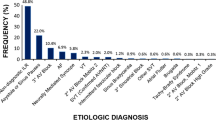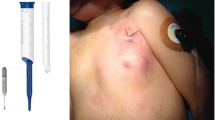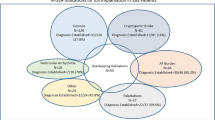Abstract
The scope of application for implantable loop recorders has shifted away from the evaluation of unclear palpitations and syncope episodes to more complex conditions. This article focuses on rare indications of growing importance such as rhythm monitoring after ablation of atrial fibrillation or after cryptogenic stroke. Furthermore, forthcoming applications in various clinical settings are described, e. g., arrhythmia detection after myocardial infarction, after catheter-based valve interventions, in heart failure, and in cardiomyopathies. Enhancement of the capabilities of implantable loop recorders could broaden their fields of use.
Zusammenfassung
Der Einsatzbereich für implantierbare Ereignisrekorder hat sich von der Abklärung unklarer Palpitationen und Synkopen zu komplexeren Zuständen verlagert. Der vorliegende Artikel setzt einen Schwerpunkt auf gegenwärtig noch seltene Indikationen, die zunehmend an Bedeutung gewinnen, wie beispielsweise Rhythmusüberwachung nach Ablation von Vorhofflimmern und nach kryptogenem Insult. Darüber hinaus werden zukünftige Anwendungen in verschiedenen klinischen Situationen beschrieben, z. B. Arrhythmiedetektion nach Myokardinfarkt, nach kathetergestützten Klappeninterventionen, bei Herzinsuffizienz und bei Kardiomyopathien. Weiterentwicklungen des Funktionsumfangs implantierbarer Ereignisrekorder könnten deren Anwendungsgebiete noch ausdehnen.

Similar content being viewed by others
References
Krahn AD, Klein GJ, Yee R, Takle-Newhouse T, Norris C, the Reveal Investigators (1999) Use of an extended monitoring strategy in patients with problematic syncope. Circulation 99:406–410
Krahn AD, Klein GJ, Yee R, Skanes AC (2001) Randomized assessment of syncope trial: conventional diagnostic testing versus a prolonged monitoring strategy. Circulation 104:46–51
Krahn AD, Klein GJ, Yee R, Hoch JS, Skanes AC (2003) Cost implications of testing strategy in patients with syncope: randomized assessment of syncope trial. J Am Coll Cardiol 42:495–501
Giada F, Gulizia M, Francese M, Croci F, Santangelo L, Santomauro M, Occetta E, Menozzi C, Raviele A (2007) Recurrent unexplained palpitations (RUP) study comparison of implantable loop recorder versus conventional diagnostic strategy. J Am Coll Cardiol 49:1951–1956
Brignole M, Vardas P, Hoffman E, Huikuri H, Moya A, Ricci R, Sulke N, Wieling W, Auricchio A, Lip GY, Almendral J, Kirchhof P, Aliot E, Gasparini M, Braunschweig F, Botto GL (2009) Indications for the use of diagnostic implantable and external ECG loop recorders. Europace 11:671–687
Kanjwal K, Figueredo VM, Karabin B, Grubb BP (2011) The implantable loop recorder: current uses, future directions. J Innov Cardiac Rhythm Manag 2:215–222
Furukawa T, Maggi R, Bertolone C, Fontana D, Brignole M (2012) Additional diagnostic value of very prolonged observation by implantable loop recorder in patients with unexplained syncope. J Cardiovasc Electrophysiol 23:67–71
Pürerfellner H, Sanders P, Pokushalov E, Di Bacco M, Bergemann T, Dekker LR, Reveal LINQ, Reveal LINQ Usability Study Investigators (2015) Miniaturized Reveal LINQ insertable cardiac monitoring system: first-in-human experience. Heart Rhythm 12:1113–1119
Tomson TT, Passman R (2015) The Reveal LINQ insertable cardiac monitor. Expert Rev Med Devices 12:7–18
Calkins H, Kuck KH, Cappato R, Brugada J, Camm AJ, Chen SA, Crijns HJ, Damiano RJ Jr, Davies DW, DiMarco J, Edgerton J, Ellenbogen K, Ezekowitz MD, Haines DE, Haissaguerre M, Hindricks G, Iesaka Y, Jackman W, Jalife J, Jais P, Kalman J, Keane D, Kim YH, Kirchhof P, Klein G, Kottkamp H, Kumagai K, Lindsay BD, Mansour M, Marchlinski FE, McCarthy PM, Mont JL, Morady F, Nademanee K, Nakagawa H, Natale A, Nattel S, Packer DL, Pappone C, Prystowsky E, Raviele A, Reddy V, Ruskin JN, Shemin RJ, Tsao HM, Wilber D (2012) 2012 HRS/EHRA/ECAS expert consensus statement on catheter and surgical ablation of atrial fibrillation: recommendations for patient selection, procedural techniques, patient management and follow-up, definitions, endpoints, and research trial design. Europace 14:528–606
Kircher S, Hindricks G, Sommer P (2012) Long-term success and follow-up after atrial fibrillation ablation. Curr Cardiol Rev 8:354–361
Ajijola OA, Boyle NG, Shivkumar K (2015) Detecting and monitoring arrhythmia recurrence following catheter ablation of atrial fibrillation. Front Physiol 6:90
Hanke T, Charitos EI, Stierle U, Karluss A, Kraatz E, Graf B, Hagemann A, Misfeld M, Sievers HH (2009) Twenty-four-hour Holter monitor follow-up does not provide accurate heart rhythm status after surgical atrial fibrillation ablation therapy: Up to 12 months experience with a novel permanently implantable heart rhythm monitor device. Circulation 120:S177–S184
Mittal S, Pokushalov E, Romanov A, Ferrara M, Arshad A, Musat D, Preminger M, Sichrovsky T, Steinberg JS (2013) Long-term ECG monitoring using an implantable loop recorder for the detection of atrial fibrillation after cavotricuspid isthmus ablation in patients with atrial flutter. Heart Rhythm 10:1598–1604
Pokushalov E, Romanov A, Corbucci G, Artyomenko S, Turov A, Shirokova N, Karaskov A (2011) Ablation of paroxysmal and persistent atrial fibrillation: 1‑Year follow-up through continuous subcutaneous monitoring. J Cardiovasc Electrophysiol 22:369–375
Gersak B, Pernat A, Robic B, Sinkovec M (2012) Low rate of atrial fibrillation recurrence verified by implantable loop recorder monitoring following a convergent epicardial and endocardial ablation of atrial fibrillation. J Cardiovasc Electrophysiol 23:1059–1066
Zuern CS, Kilias A, Berlitz P, Seizer P, Gramlich M, Müller K, Duckheim M, Gawaz M, Schreieck J (2015) Anticoagulation after catheter ablation of atrial fibrillation guided by implantable cardiac monitors. Pacing Clin Electrophysiol 38:688–693
Pohl M, Mayer J, Sitzy J, Huo Y, Richter U, Gaspar T, Piorkowski C (2016) P514 – Discontinuation of Anticoagulation with Continuous Remote Insertable Cardiac Monitoring in Atrial Fibrillation – The DACRIMA Study. http://www.abstractserver.de/dgk2016/ht/abstracts/P514.htm
Glotzer TV, Daoud EG, Wyse DG, Singer DE, Ezekowitz MD, Hilker C, Miller C, Qi D, Ziegler PD (2009) The relationship between daily atrial tachyarrhythmia burden from implantable device diagnostics and stroke risk: the TRENDS study. Circ Arrhythm Electrophysiol 2:474–480
Healey JS, Connolly SJ, Gold MR, Israel CW, Van Gelder IC, Capucci A, Lau CP, Fain E, Yang S, Bailleul C, Morillo CA, Carlson M, Themeles E, Kaufman ES, Hohnloser SH, ASSERT Investigators (2012) Subclinical atrial fibrillation and the risk of stroke. N Engl J Med 366:120–129
Ziegler PD, Glotzer TV, Daoud EG, Singer DE, Ezekowitz MD, Hoyt RH, Koehler JL, Coles J Jr, Wyse DG (2012) Detection of previously undiagnosed atrial fibrillation in patients with stroke risk factors and usefulness of continuous monitoring in primary stroke prevention. Am J Cardiol 110:1309–1314
Etgen T, Hochreiter M, Mundel M, Freudenberger T (2013) Insertable cardiac event recorder in detection of atrial fibrillation after cryptogenic stroke: an audit report. Stroke 44:2007–2009
Gladstone DJ, Spring M, Dorian P, Panzov V, Thorpe KE, Hall J, Vaid H, O’Donnell M, Laupacis A, Côté R, Sharma M, Blakely JA, Shuaib A, Hachinski V, Coutts SB, Sahlas DJ, Teal P, Yip S, Spence JD, Buck B, Verreault S, Casaubon LK, Penn A, Selchen D, Jin A, Howse D, Mehdiratta M, Boyle K, Aviv R, Kapral MK, Mamdani M, EMBRACE Investigators and Coordinators (2014) Atrial fibrillation in patients with cryptogenic stroke. N Engl J Med 370:2467–2477
Rem JA, Hachinski VC, Boughner DR, Barnett HJ (1985) Value of cardiac monitoring and echocardiography in TIA and stroke patients. Stroke 16:950–956
Hornig CR, Haberbosch W, Lammers C, Waldecker B, Dorndorf W (1996) Specific cardiological evaluation after focal cerebral ischemia. Acta Neurol Scand 93:297–302
Schuchert A, Behrens G, Meinertz T (1999) Impact of long-term ECG recording on the detection of paroxysmal atrial fibrillation in patients after an acute ischemic stroke. Pacing Clin Electrophysiol 22:1082–1084
Barthelemy JC, Feasson-Gerard S, Garnier P, Gaspoz JM, Da Costa A, Michel D, Roche F (2003) Automatic cardiac event recorders reveal paroxysmal atrial fibrillation after unexplained strokes or transient ischemic attacks. Ann Noninvasive Electrocardiol 8:194–199
Jabaudon D, Sztajzel J, Sievert K, Landis T, Sztajzel R (2004) Usefulness of ambulatory 7‑day ECG monitoring for the detection of atrial fibrillation and flutter after acute stroke and transient ischemic attack. Stroke 35:1647–1651
Schaer BA, Zellweger MJ, Cron TA, Kaiser CA, Osswald S (2004) Value of routine Holter monitoring for the detection of paroxysmal atrial fibrillation in patients with cerebral ischemic events. Stroke 35:e68–e70
Shafqat S, Kelly PJ, Furie KL (2004) Holter monitoring in the diagnosis of stroke mechanism. Intern Med J 34:305–309
Tagawa M, Takeuchi S, Chinushi M, Saeki M, Taniguchi Y, Nakamura Y, Ohno H, Kitazawa K, Aizawa Y (2007) Evaluating patients with acute ischemic stroke with special reference to newly developed atrial fibrillation in cerebral embolism. Pacing Clin Electrophysiol 30:1121–1128
Liao J, Khalid Z, Scallan C, Morillo C, O’Donnell M (2007) Noninvasive cardiac monitoring for detecting paroxysmal atrial fibrillation or flutter after acute ischemic stroke: a systematic review. Stroke 38:2935–2940
Sanna T, Diener HC, Passman RS, Di Lazzaro V, Bernstein RA, Morillo CA, Rymer MM, Thijs V, Rogers T, Beckers F, Lindborg K, Brachmann J, CRYSTAL AF Investigators (2014) Cryptogenic stroke and underlying atrial fibrillation. N Engl J Med 370:2478–2486
Montenero AS, Quayyum A, Franciosa P, Mangiameli D, Antonelli A, Barbieri L, Bruno N, Zumbo F, Vimercati M (2004) Implantable loop recorders: a novel method to judge patient perception of atrial fibrillation. Preliminary results from a pilot study. J Interv Card Electrophysiol 10:211–220
Strickberger SA, Ip J, Saksena S, Curry K, Bahnson TD, Ziegler PD (2005) Relationship between atrial tachyarrhythmias and symptoms. Heart Rhythm 2:125–131
Bloch Thomsen PE, Jons C, Raatikainen MJ, Moerch Joergensen R, Hartikainen J, Virtanen V, Boland J, Anttonen O, Gang UJ, Hoest N, Boersma LV, Platou ES, Becker D, Messier MD, Huikuri HV, Cardiac Arrhythmias and Risk Stratification After Acute Myocardial Infarction (CARISMA) Study Group (2010) Long-term recording of cardiac arrhythmias with an implantable cardiac monitor in patients with reduced ejection fraction after acute myocardial infarction: the Cardiac Arrhythmias and Risk Stratification After Acute Myocardial Infarction (CARISMA) study. Circulation 122:1258–1264
Kapa S, Epstein AE, Callans DJ, Garcia FC, Lin D, Bala R, Riley MP, Hutchinson MD, Gerstenfeld EP, Tzou W, Marchlinski FE, Frankel DS, Cooper JM, Supple G, Deo R, Verdino RJ, Patel VV, Dixit S (2013) Assessing arrhythmia burden after catheter ablation of atrial fibrillation using an implantable loop recorder: the ABACUS study. J Cardiovasc Electrophysiol 24:875–881
Verma A, Champagne J, Sapp J, Essebag V, Novak P, Skanes A, Morillo CA, Khaykin Y, Birnie D (2013) Discerning the incidence of symptomatic and asymptomatic episodes of atrial fibrillation before and after catheter ablation (DISCERN AF): a prospective, multicenter study. JAMA Intern Med 173:149–156
Bax JJ, Delgado V, Bapat V, Baumgartner H, Collet JP, Erbel R, Hamm C, Kappetein AP, Leipsic J, Leon MB, MacCarthy P, Piazza N, Pibarot P, Roberts WC, Rodés-Cabau J, Serruys PW, Thomas M, Vahanian A, Webb J, Zamorano JL, Windecker S (2014) Open issues in transcatheter aortic valve implantation. Part 2: procedural issues and outcomes after transcatheter aortic valve implantation. Eur Heart J 35:2639–2654
Siontis GC, Jüni P, Pilgrim T, Stortecky S, Büllesfeld L, Meier B, Wenaweser P, Windecker S (2014) Predictors of permanent pacemaker implantation in patients with severe aortic stenosis undergoing TAVR: a meta-analysis. J Am Coll Cardiol 64:129–140
Ensminger S, Loders S, Beckendorf C, Feyrer R, Ludwig J, Achenbach S, Weyand M, Arnold M (2013) Continuous rhythm monitoring after Transcatheter Aortic Valve Implantation using an implantable loop recorder. Thorac Cardiovasc Surg 61(S01). doi:10.1055/s-0032-1332418
Schymik G, Würth A, Bramlage P, Herbinger T, Heimeshoff M, Pilz L, Schymik JS, Wondraschek R, Süselbeck T, Gerhardus J, Luik A, Gonska BD, Posival H, Schmitt C, Schröfel H (2015) Long-term results of transapical versus transfemoral TAVI in a real world population of 1000 patients with severe symptomatic aortic stenosis. Circ Cardiovasc Interv 8:e000761
Urena M, Rodés-Cabau J (2015) Managing heart block after transcatheter aortic valve implantation: from monitoring to device selection and pacemaker indications. EuroIntervention 11(Suppl W):W101–W105
Athappan G, Gajulapalli RD, Tuzcu ME, Svensson LG, Kapadia SR (2016) A systematic review on the safety of second-generation transcatheter aortic valves. EuroIntervention 11:1034–1043
Biancari F, Rosato S, D’Errigo P, Ranucci M, Onorati F, Barbanti M, Santini F, Tamburino C, Santoro G, Grossi C, Covello RD, Ventura M, Fusco D, Seccareccia F, OBSERVANT Research Group (2016) Immediate and intermediate outcome after transapical versus transfemoral transcatheter aortic valve replacement. Am J Cardiol 117:245–251
Massoullié G, Bordachar P, Ellenbogen KA, Souteyrand G, Jean F, Combaret N, Vorilhon C, Clerfond G, Farhat M, Ritter P, Citron B, Lusson JR, Motreff P, Ploux S, Eschalier R (2016) New-onset left bundle branch block induced by transcutaneous aortic valve implantation. Am J Cardiol 117:867–873
Schernthaner C, Kraus J, Danmayr F, Hammerer M, Schneider J, Hoppe UC, Strohmer B (2016) Short-term pacemaker dependency after transcatheter aortic valve implantation. Wien Klin Wochenschr 128:198–203
Kuck KH, Bordachar P, Borggrefe M, Boriani G, Burri H, Leyva F, Schauerte P, Theuns D, Thibault B, Kirchhof P, Hasenfuss G, Dickstein K, Leclercq C, Linde C, Tavazzi L, Ruschitzka F (2014) New devices in heart failure: an European Heart Rhythm Association report: developed by the European Heart Rhythm Association; endorsed by the Heart Failure Association. Europace 16:109–128
Ahmad K (2009) The role of the ICD in the prevention of sudden death. Cardiol Rounds 13:10
Brignole M, Auricchio A, Baron-Esquivias G, Bordachar P, Boriani G, Breithardt OA, Cleland J, Deharo JC, Delgado V, Elliott PM, Gorenek B, Israel CW, Leclercq C, Linde C, Mont L, Padeletti L, Sutton R, Vardas PE (2013) 2013 ESC Guidelines on cardiac pacing and cardiac resynchronization therapy. Eur Heart J 34:2281–2329
Bennett T, Kjellstrom B, Taepke R, Ryden L (2005) Development of implantable devices for continuous ambulatory monitoring of central hemodynamic values in heart failure patients. Pacing Clin Electrophysiol 28:573–584
Author information
Authors and Affiliations
Corresponding author
Ethics declarations
Conflict of interest
S. Wechselberger declares that he has no competing interests. M. Pohl has received modest educational sponsoring from St. Jude Medical and congress sponsoring from Medtronic. C. Piorkowski has received modest lecture honoraria and research support from St. Jude Medical and Biotronik, and is a member of the St. Jude Medical advisory board.
This article does not contain any studies with human participants or animals performed by any of the authors.
Rights and permissions
About this article
Cite this article
Wechselberger, S., Piorkowski, C. & Pohl, M. Current rare indications and future directions for implantable loop recorders. Herzschr Elektrophys 27, 366–370 (2016). https://doi.org/10.1007/s00399-016-0475-x
Published:
Issue Date:
DOI: https://doi.org/10.1007/s00399-016-0475-x




